As the site is updated, each listing includes the shipping cost. Some listings which I have not updated still give you calculated shipping costs based on weight and size of package. (In the sections I have updated) If you select several different listings, we will consolidate your order and charge you the actual cost of the entire package. The shipping over charge will be refunded to you, when your order is shipped.
SCALLOP SHELLS FROM AROUND THE WORLD ENCOMPASSING ALL THE POPULAR SIZES AND PRICES
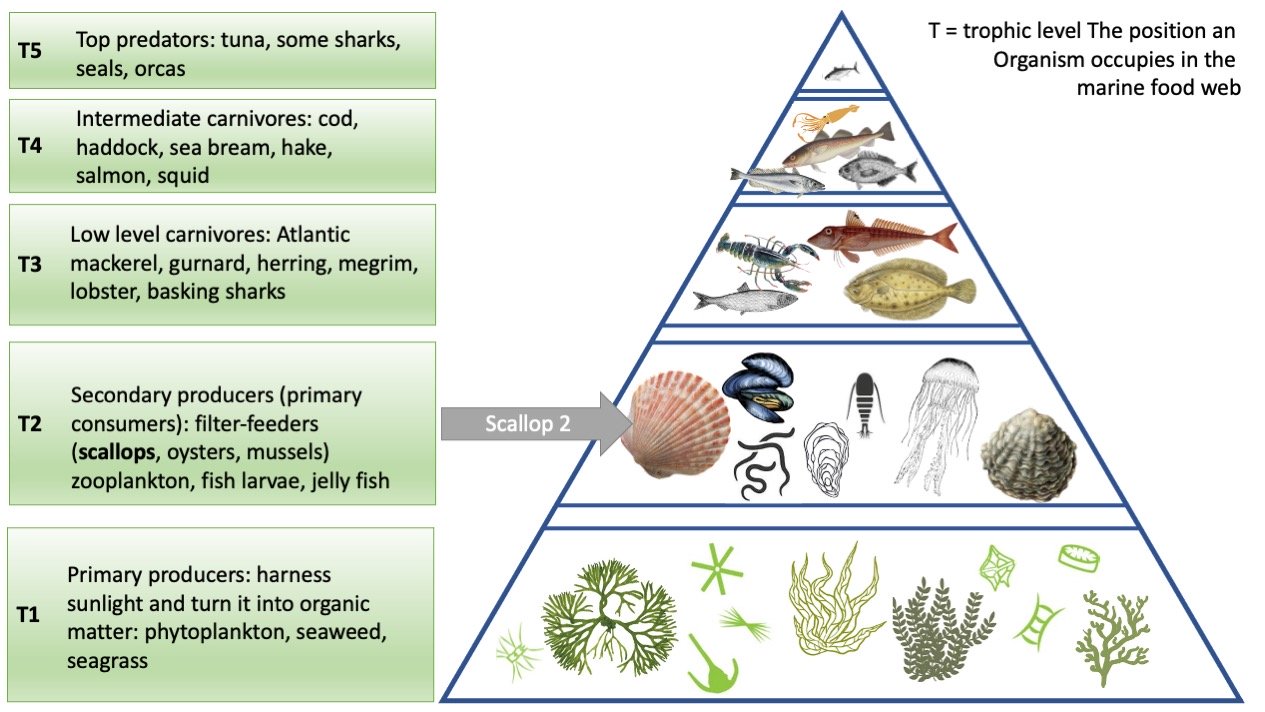
Scallops in the Marine Food Pyramid
Scallop is a common name that encompasses various species of marine bivalve mollusks in the taxonomic family Pectinidae, the scallops. However, the common name "scallop" can apply to species in other closely related families within the superfamily Pectinoidea, which also includes the thorny oysters.
Taxonomic means relating to a system for naming and organizing things, especially plants and animals, into groups that have similar qualities.
Scallops are a cosmopolitan family of bivalves found in all of the world's oceans, although never in fresh water. The largest number of species live in the Indo-Pacific region. Most species dwell in relatively shallow waters from the low tide line to depths of 328 feet, while others prefer much deeper water. Although some species only live in very narrow environments, most are opportunistic and can live under a wide variety of conditions. Scallops can be found living within, upon, or under either rocks, coral, rubble, sea grass, kelp, sand, or mud. Most scallops begin their lives as byssally attached juveniles, an ability that some retain throughout their lives while others grow into free-living adults.
byssally is used when referring to the main or most important characteristic or feature of something.
They are one of the very few groups of bivalves to be primarily "free-living", with many species capable of rapidly swimming short distances and even migrating some distance across the ocean floor. A small minority of scallop species live cemented to rocky substrates as adults, while others attach themselves to stationary or rooted objects such as seagrass at some point in their lives by means of a filament they secrete called a byssal thread. The majority of species, however, live recumbent on sandy substrates, and when they sense the presence of a predator such as a starfish, they may attempt to escape by swimming swiftly but erratically through the water using jet propulsion created by repeatedly clapping their shells together.Scallops have a well-developed nervous system, and unlike most other bivalves all scallops have a ring of numerous simple eyes situated around the edge of their mantles.
substrate the base on which an organism lives. the soil is the substrate of most seed plants.
cosmopolitan distribution is the range of a taxon that extends across all of (or most of) the world, in appropriate habitats; most cosmopolitan species are known to be highly adaptable to a range of climatic and environmental conditions, though this is not always so.
taxon is a group of one or more populations of an organism or organisms seen by taxonomists to form a unit.
Many species of scallops are highly prized as a food source, and some are farmed as aquaculture. The word "scallop" is also applied to the meat of these bivalves, the adductor muscle, that is sold as seafood. The brightly colored, symmetric, fan-shaped shells of scallops with their radiating and often fluted ornamentation are valued by shell collectors, and have been used since ancient times as motifs in art, architecture, and design.
Very little variation occurs in the internal arrangement of organs and systems within the scallop family, and what follows can be taken to apply to the anatomy of any given scallop species.
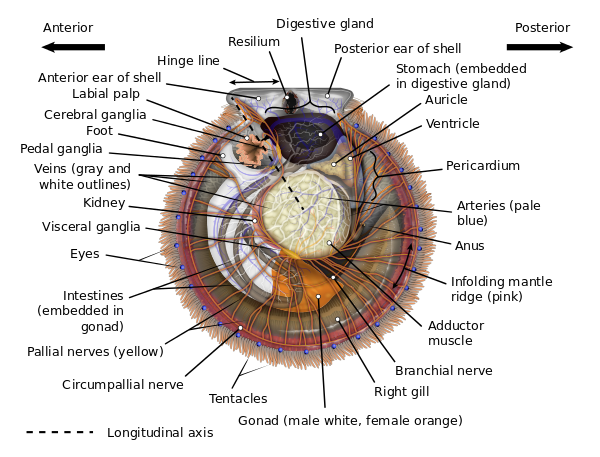
The shell of a scallop consists of two sides or valves, a left valve and a right one, divided by a plane of symmetry (the quality of being made up of exactly similar parts facing each other or around an axis). Most species of scallops rest on their right valve, and consequently, this valve is often deeper and more rounded than the left (i.e., upper) valve, which in many species is actually concave. With the hinge of the two valves oriented towards the top, one side corresponds to the animal's morphological anterior or front, the other is the posterior or rear, the hinge is the dorsal or back/top region, and the bottom corresponds to the ventral or (as it were) underside/belly. Many scallop shells are more or less bilaterally symmetrical ("equivalved"), as well as symmetrical front/back ("equilateral"), determining which way a given animal is "facing" requires detailed information about its valves.
The model scallop shell consists of two similarly shaped valves with a straight hinge line along the top, devoid of teeth, and producing a pair of flat wings or "ears" (sometimes called "auricles", though this is also the term for two chambers in its heart) on either side of its midpoint, a feature which is unique to and apparent in all adult scallops. These ears may be of similar size and shape, or the anterior ear may be somewhat larger (the posterior ear is never larger than the anterior one, an important feature for distinguishing which valve is which). As is the case in almost all bivalves, a series of lines and/or growth rings originates at the center of the hinge, at a spot called the "beak" surrounded by a generally raised area called the "umbo". These growth rings increase in size downwards until they reach the curved ventral edge of the shell. The shells of most scallops are streamlined to facilitate ease of movement during swimming at some point in their lifecycles, while also providing protection from predators. Scallops with ridged valves have the advantage of the architectural strength provided by these ridges called "ribs", although the ribs are somewhat costly in weight and mass. A unique feature of the scallop family is the presence, at some point during the animal's lifecycle, of a distinctive and taxonomically important shell feature, a comb-like structure called a (ctenolium a comb-like gill, part of the respiratory system of mollusks) located on the anterior edge of the right valve next to the valve's byssal notch. Though many scallops lose this feature as they become free-swimming adults, all scallops have a ctenolium at some point during their lives, and no other bivalve has an analogous shell feature. The ctenolium is found in modern scallops only; both putative ancestors of modern scallops, the entoliids and the Aviculopectinidae, did not possess it.
Scallops possess fast (striated) and slow (smooth) adductor muscles, which have different structures and (contractile capable of contracting or being contracted) properties. These muscles lie closely apposed to one another but are divided by a connective tissue sheet. The striated adductor muscle contracts very quickly for swimming, whereas the smooth catch adductor muscle lacks striations, and contracts for long periods, keeping shells closed with little expenditure of energy.
Scallops are filter feeders, and eat plankton. Unlike many other bivalves, they lack siphons. Water moves over a filtering structure, where food particles become trapped in mucus. Next, the cilia on the structure move the food toward the mouth. Then, the food is digested in the digestive gland, an organ sometimes misleadingly referred to as the "liver, " which envelops part of the oesophagus (the part of the alimentary canal which connects the throat to the stomach. In humans and other vertebrates it is a muscular tube lined with mucous membrane), intestine, and entire stomach. Waste is passed on through the intestine (the terminus of which, like that of many mollusks, enters and leaves the animal's heart) and exits via the anus.
siphon is a tube used to convey liquid upwards from a reservoir and then down to a lower level of its own accord. Once the liquid has been forced into the tube, typically by suction or immersion, flow continues unaided.
Like all bivalves, scallops lack actual brains. Instead, their nervous system is controlled by three paired ganglia (a structure containing a number of nerve cell bodies, typically linked by synapses, and often forming a swelling on a nerve fiber) located at various points throughout their anatomy, the cerebral or cerebropleural ganglia, the pedal ganglia, and the visceral or parietovisceral ganglia. All are yellowish. The visceral ganglia are by far the largest and most extensive of the three, and occur as an almost-fused mass near the center of the animal – proportionally, these are the largest and most intricate sets of ganglia of any modern bivalve. From this, radiate all of the nerves which connect the visceral ganglia to the circumpallial nerve ring which loops around the mantle and connects to all of the scallop's tentacles and eyes. This nerve ring is so well developed that, in some species, it may be legitimately considered an additional ganglion. The visceral ganglia are also the origin of the branchial nerves which control the scallop's gills. The cerebral ganglia are the next-largest set of ganglia and lie distinct from each other a significant distance dorsal to the visceral ganglia. They are attached to the visceral ganglia by long cerebral-visceral connectives, and to each other via a cerebral commissure (a band of nerve tissue connecting the hemispheres of the brain, the two sides of the spinal cord) that extends in an arch dorsally around the esophagus. The cerebral ganglia control the scallop's mouth via the palp nerves and connect to statocysts which help the animal sense its position in the surrounding environment. They are connected to the pedal ganglia by short cerebral-pedal connectives. The pedal ganglia, though not fused, are situated very close to each other near the midline. From the pedal ganglia, the scallop puts out pedal nerves which control the movement of, and sensation in, its small muscular foot.
Scallops have a large number (up to 200) of small (about 1/8 inch) eyes arranged along the edge of their mantles. These eyes represent a particular innovation among mollusks, relying on a concave, parabolic mirror of guanine (a white almost insoluble compound: one of the purine bases in nucleic acids) crystals to focus and retro-reflect light instead of a lens as found in many other eye types. Their eyes possess a double-layered retina, the outer retina responding most strongly to light and the inner to abrupt darkness. While these eyes are unable to resolve shapes with high fidelity, the combined sensitivity of both retinas to light entering the eye and light retro-reflected from the mirror grants scallops exceptional contrast definition, as well as the ability to detect changing patterns of light and motion. Scallops primarily rely on their eyes as an 'early-warning' threat detection system, scanning around them for movement and shadows which could potentially indicate predators. Some scallops alter their swimming or feeding behavior based on the turbidity or clarity of the water, by detecting the movement of particulate matter in the water column.
Scallops are mostly free-living and active, unlike the vast majority of bivalves, which are mostly slow-moving and infaunal (Aquatic animals, such as clams or burrowing worms, that live beneath the surface of a sea or lake floor). All scallops are thought to start out with a byssus, which attaches them to some form of substrate such as eelgrass when they are very young. Most species lose the byssus as they grow larger. A very few species go on to cement themselves to a hard substrate.
the majority of scallops are free-living and can swim with brief bursts of speed to escape predators (mostly starfish) by rapidly opening and closing their valves. Everything about their characteristic shell shape – its symmetry, narrowness, smooth and/ or grooved surface, small flexible hinge, powerful adductor muscle, and continuous and uniformly curved edge – facilitates such activity. They often do this in spurts of several seconds before closing the shell entirely and sinking back to the bottom of their environment. Scallops are able to move through the water column either forward/ventrally (termed swimming) by sucking water in through the space between their valves, an area called the gape, and ejecting it through small holes near the hinge line called exhalant apertures, or backward/dorsally (termed jumping) by ejecting the water out the same way it came in (i.e. ventrally). A jumping scallop usually lands on the sea floor between each contraction of its valves, whereas a swimming scallop stays in the water column for most or all of its contractions and travels a much greater distance (though seldom at a height of more than 3 feet off the sea bed and seldom for a distance of greater than 16 feet). The jumping and swimming movements are very energy-intensive, and most scallops cannot perform more than four or five in a row before becoming completely exhausted and requiring several hours of rest. Should a swimming scallop land on its left side, it is capable of flipping itself over to its right side via a similar shell-clapping movement called the righting reflex. So-called singing scallops are rumored to make an audible, soft popping sound as they flap their shells underwater (this is debatable). Other scallops can extend their foot from between their valves, and by contracting the muscles in their foot, they can burrow into sand.
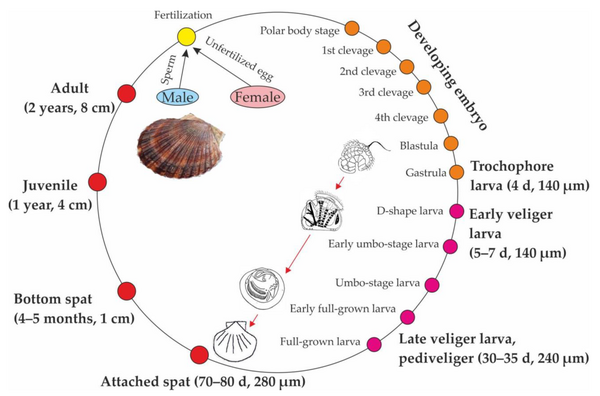
Life cycle of the giant Yesso scallop found north of Japan
The scallop family is unusual in that some members of the family are dioecious (males and females are separate), while others are simultaneous hermaphrodites (both sexes in the same individual), and a few are protoandrous hermaphrodites (males when young then switching to female). Female scallops have red roe and male scallops have white roe. Spermatozoa and ova are released freely into the water during mating season and fertilized ova sink to the bottom. After several weeks, the immature scallops hatch and the larvae, miniature transparent versions of the adults called "spat", drift in the plankton until settling to the bottom again (an event called spatfall) to grow, usually attaching by means of byssal threads. Some scallops, such as the Atlantic bay scallop Argopecten irradians, are short-lived, while others can live 20 years or more. Age can often be inferred from annuli, the concentric rings of their shells.
At the age of two, scallops usually become sexually active, but do not contribute significantly to egg production until four. The reproduction process occurs externally through spawning, in which eggs and sperm are released into the water. Spawning typically occurs in late summer and early autumn; spring spawning may also take place in the Mid-Atlantic Bight. The females of scallops are highly fecund, capable of producing hundreds of millions of eggs per year.
Once an egg is fertilized, it is then planktonic, a collection of microorganisms that drift abundantly in fresh or salt water. Larvae stay in the water column for four to seven weeks before dissipating to the ocean floor, where they attach themselves to objects through byssus threads. Byssus is eventually lost with adulthood, transitioning almost all scallop species into free swimmers. Rapid growth occurs within the first several years, with an increase of 50–80 % in shell height and quadrupled size in meat weight, and reaches a commercial size at about four to five years of age. The lifespans of some scallops have been known to extend over 20 years.
Scientific classification
Domain: Eukaryota
Kingdom: Animalia
Phylum: Mollusca
Class: Bivalvia
Order: Pectinida
Superfamily: Pectinoidea
Family: Pectinidae
Wilkes, 1810
(REF: Whitney, D.W. (1890) Scallop The Century Dictionary: An Encyclopedic Lexicon of the English Language p.5371, Century Company, and (2009) The Oxford English Dictionary, Second Edition (REF: Harris, Olivia K.; Kingston, Alexandra C. N.; Wolfe, Caitlin S.; Ghoshroy, Soumitra; Johnsen, Sönke; Speiser, Daniel I. (2019). "Core–shell nanospheres behind the blue eyes of the bay scallop Argopecten irradians". Journal of the Royal Society Interface)(REF: Speiser, Daniel I.; Johnsen, Sönke (1 July 2008). "Scallops visually respond to the size and speed of virtual particles". Journal of Experimental Biology )(REF: Purcell, E. M. (1977), "Life at low reynolds number", American Journal of Physics, 45)(REF: Cheng, J.-Y.; Davison, I. G.; Demont, M. E. (1996). "Dynamics and energetics of scallop locomotion". Journal of Experimental Biology. 199)(REF: Joll, L. M. (1989). "Swimming behavior of the saucer scallop Amusium balloti (Mollusca: Pectinidae)". Marine Biology. 102)(REF: Land, M.F. (1966). "Activity in the optic nerve of Pecten maximus in response to changes in light intensity, and to pattern and movements in optical environment" (PDF). Journal of Experimental Biology. 45)(REF:Guerra, C.; Zenteno-Savín, T.; Maeda-Martínez, A. N.; Abele, D.; Philipp, E. E. R. (2013). "The effect of predator exposure and reproduction on oxidative stress parameters in the Catarina scallop Argopecten ventricosus". Comparative Biochemistry and Physiology A. 165 )(REF: Dvoretsky, Alexander G.; Dvoretsky, Vladimir G. (2022-05-19). "Biological Aspects, Fisheries, and Aquaculture of Yesso Scallops in Russian Waters of the Sea of Japan")(REF: Alejandrino, A.; Puslednik, L.; Serb, J. M. (2011). "Convergent and parallel evolution in life habit of the scallops". BMC Evolutionary Biology. 11 )(REF: "Scallops". Forest and Bird.)(REF: Gosling, Elizabeth (27 April 2015). Marine Bivalve Molluscs. John Wiley & Sons)(REF: Mollusca - Bivalvia - Pectinidae at Natural History Museum Rotterdam – photos of Pectinidae shells)
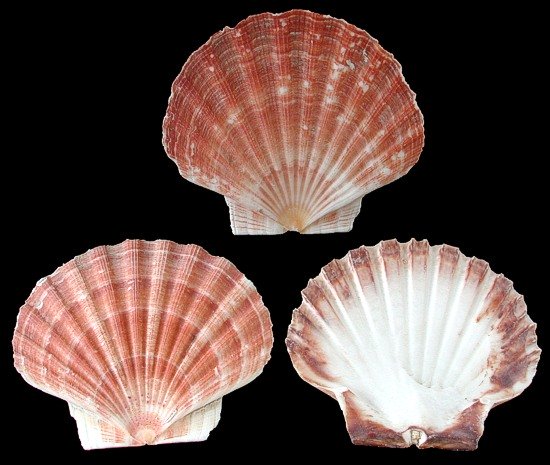
IRISH FLAT SCALLOP SHELLS
C0-1-14
One Irish Flat Scallop measuring 3 to 4 1/2 inches..... .75
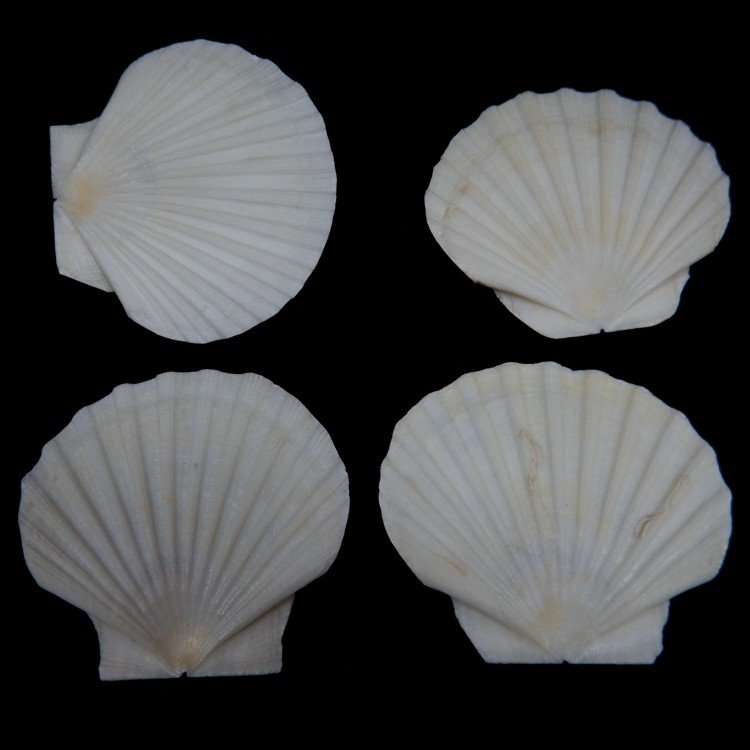
A5-14
One Irish Baking shell measuring 3 1/2 to 4 inches...... .59
A1-14
One Irish Baking shell measuring 4 1/2 to 5 inches.... .89
A6-14
One approximately 5" Irish Baking shell .... 2.80
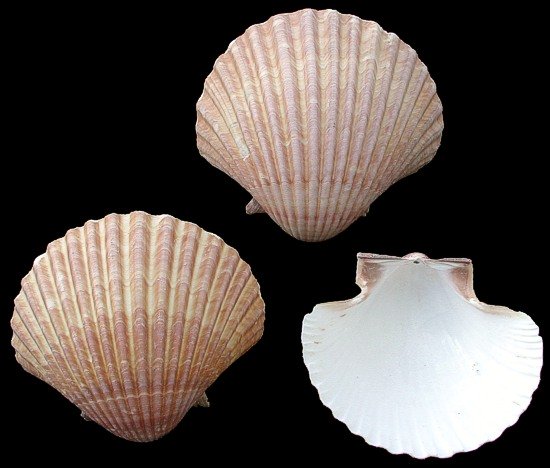
MEXICAN DEEP SCALLOP SHELLS
These are bivalve shells. This means the mollusk has created a bottom shell and a matching top shell, joint together by a ligament. Most scallops have been gathered for centuries as food. The young scallops usually attach themselves to hard objects with their byssus. Mexican Deep Scallops, like other scallops prefer offshore sandy or stone filled sea floors. These Scallops are found in the Eastern Pacific.
B2-14
A Mexican Deep Scallop measuring at least 3 inches...... .69
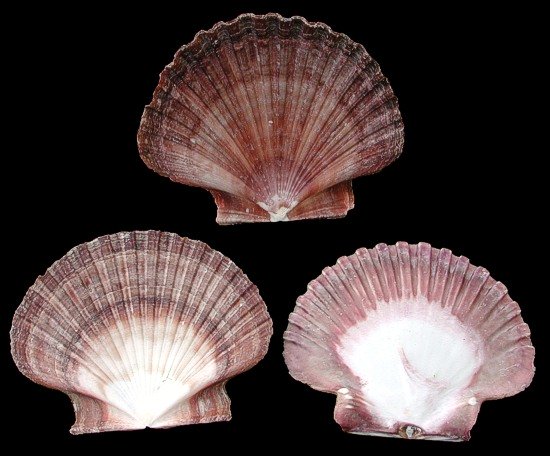
MEXICAN FLAT SCALLOP SHELL
The Mexican Flat Scallop is a bivalve shell. This means the mollusk has created a bottom shell and a matching top shell joint together by a ligament. Most scallops have been gathered for centuries as food. The young scallops usually attach themselves to hard objects with their byssus. Mexican Flat Scallops, like other scallops prefer offshore sandy or stone filled sea floors. Scallops are found worldwide.
J1-14
A Mexican Flat Scallop measuring 2 3/4 to 3 inches ...... .29
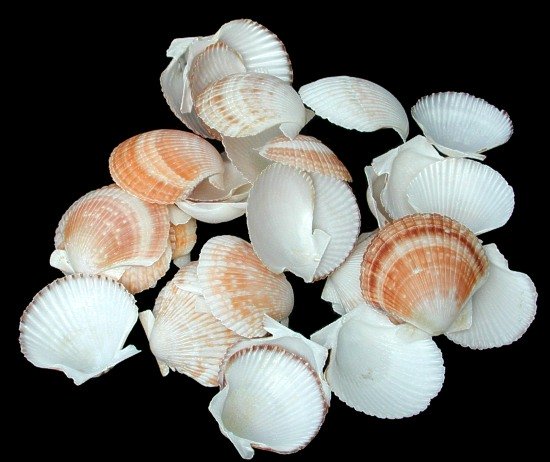
BABY DEEP SCALLOP SHELLS
The Baby Deep Scallop is a type of bivalve mollusk, characterized by a bottom and a matching top shell connected by a ligament. For centuries, scallops have been harvested as a food source. Young scallops typically anchor themselves to solid objects using their byssus. Like other scallop species, Baby Deep Scallops favor habitats with sandy bottoms or areas strewn with stones.
PP1-8
One quarter pound of Baby Deep Scallops measuring 1 1/2 to 2 inches....... $1.32
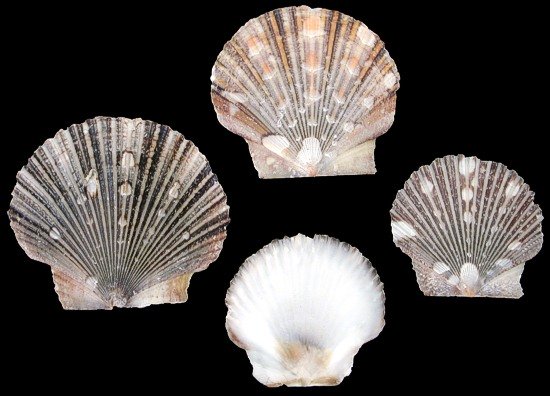
BABY FLAT SCALLOP SHELLS
The Baby Flat Scallop is a type of bivalve mollusk, which means it has a pair of hinged shells connected by a ligament. For centuries, scallops have been harvested as a food source. Young scallops typically anchor themselves to solid surfaces using their byssus threads. Like other scallop species, Baby Flat Scallops favor sandy or rocky seabeds offshore. Scallops are distributed globally.
P2-10
One quarter pound of Baby Flat Scallops measuring 1 1/2 to 2 inches.... $1.32
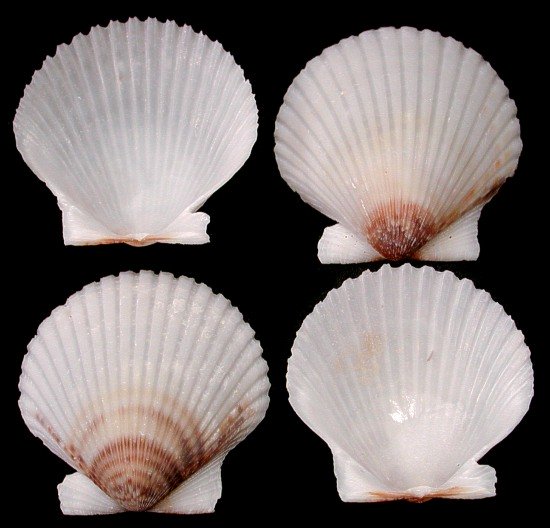
FLORIDA SCALLOP SHELLS
The Florida Scallop is a bivalve mollusk, meaning it has both a bottom and a top shell connected by a ligament. The Florida Scallops available for purchase are not matching pairs but a combination of single upper and lower shells. Scallops have been harvested as a food source for centuries. Juvenile scallops typically anchor themselves to solid surfaces using their byssus. Like their counterparts, Florida Scallops favor offshore sandy or rocky seabeds. Scallops are a common species found across the globe.
WS1-14
A single Florida Scallop measuring 1 3/4 to 2 inches ...... .23
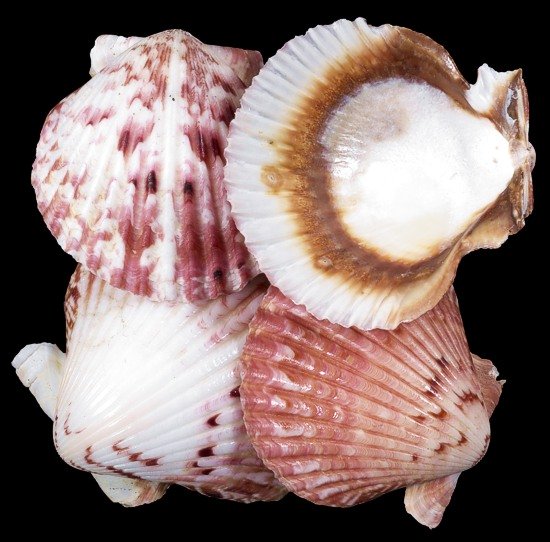
CALICO SCALLOP SINGLES
Calico Scallops are among the best-known bivalves, characterized by their fan shape and unequal-sized ears flanking the umbones. The ear extends from the hinge region of the shell, while the umbo, the earliest formed part of the shell's valve, is central. Abundant in the Southeast U.S. and Caribbean, Calico Scallops have gained popularity among jewelry crafters. Typically, they are sold individually, not as matching pairs of bivalve upper and lower shells.
I0-14
A Calico Scallop Single measuring 1 1/2 to 2 inches ...... .13
I1-14
A Calico Scallop Single measuring 2 to 2 1/2 inches...... .17
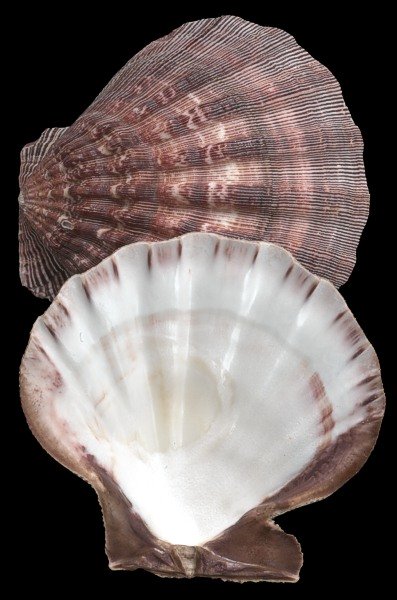
Nodipecten nodosus common name is the lion's paw scallop
the lion's paw scallop, is a species of bivalve mollusk in the family Pectinidae. It can be found along the Atlantic coast of North America, ranging from Cape Hatteras to the West Indies, including Brazil and Bermuda.
The lion's paw scallop is a species that consists of large scallop shells with ridges and bumps that have a rough texture. The lion's paw size can range from 2 1/2 to 6 inches long and are nearly circular. The shell is known for its distinct knobs on the ridges. The shell color ranges from red to orange and also purple. The shell's common name is derived from its appearance, the color, and the knobs giving it some visual similarities to the paw of a lion.
The lions paw is the largest scallop of the Western-Atlantic Ocean, it has been commercially fished for human consumption for decades. There has been a recent decline of fisheries along with an increase in the shell's value has led to aquaculture specific to the species. Their high growth rate makes them popular; however, not much is known about the requirements to improve farming. They are aqua farmed in the Caribbean particularly in Colombia due to their quick growth rate. Their popularity in commercial fishing near Brazil, makes the native lions paw at risk of extinction.
Lion's paw scallops are known to be hermaphroditic, so each species has both male and female gonads. In external fertilization, an organism will release both eggs and sperm. Lion's paw scallops spawn twice a year. Along the coast of Brazil, they are known to spawn once in the winter and once again in the summer.
The lion's paw shell is valuable to collectors because of its size, vibrant colors, and extremely distinctive features. Because of its large size and it being more common in deeper, rocky waters, they are rarely found intact on sandy beaches.
The lion's paw scallop is an epibenthic bivalve that usually lives on rocks inside of caves or in shaded areas.
Epibenthic refers to organisms That live on the surface of sediments at the bottom of the sea.
Scientific classification
Domain: Eukaryota
Kingdom: Animalia
Phylum: Mollusca
Class: Bivalvia
Order: Pectinida
Family: Pectinidae
Genus: Nodipecten
Species: Nodipecten nodosus
Binomial name: Nodipecten nodosus
(Linnaeus, 1758)
R2-14
A 5 to 6 inch Purple Lions Paw Single......$2.10
R1-14
One 5 to 6 inch Lions Paw Pair a matching upper and lower shell.. OUT OF STOCK
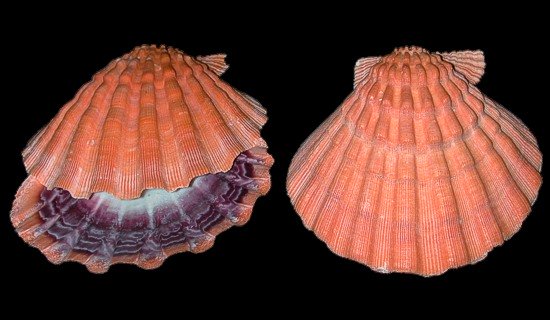
ZZ1-14
One 5 to 6 inch Orange lion's Paw Scallop Shell Pair (matching top and bottom of bivavle shell)......OUT OF STOCK
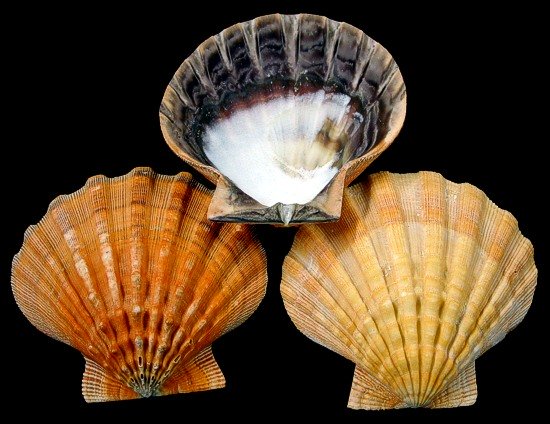
Z2-14
One 5 to 6 inch Orange Lions Paw Scallop Single ...... OUT OF STOCK